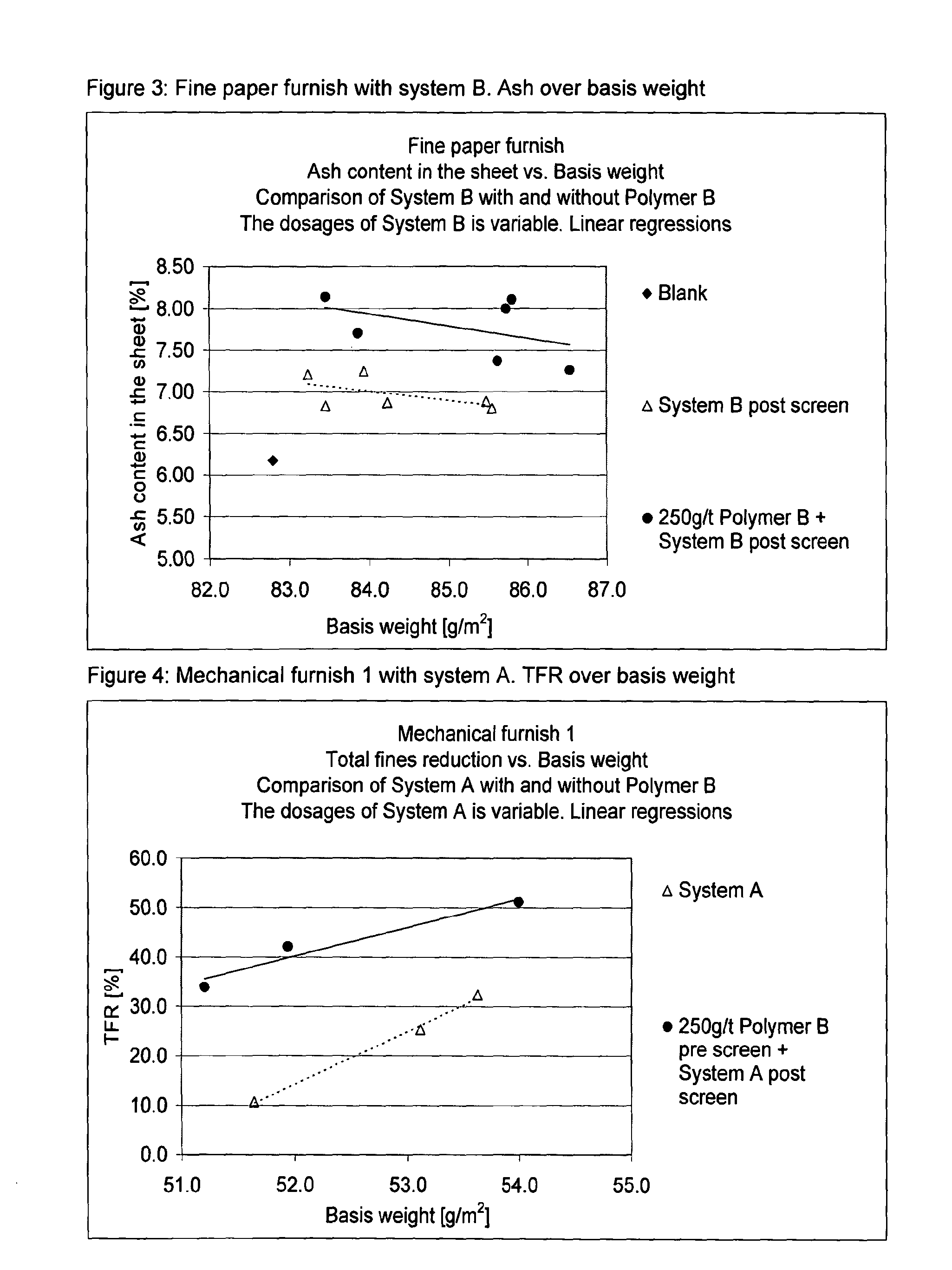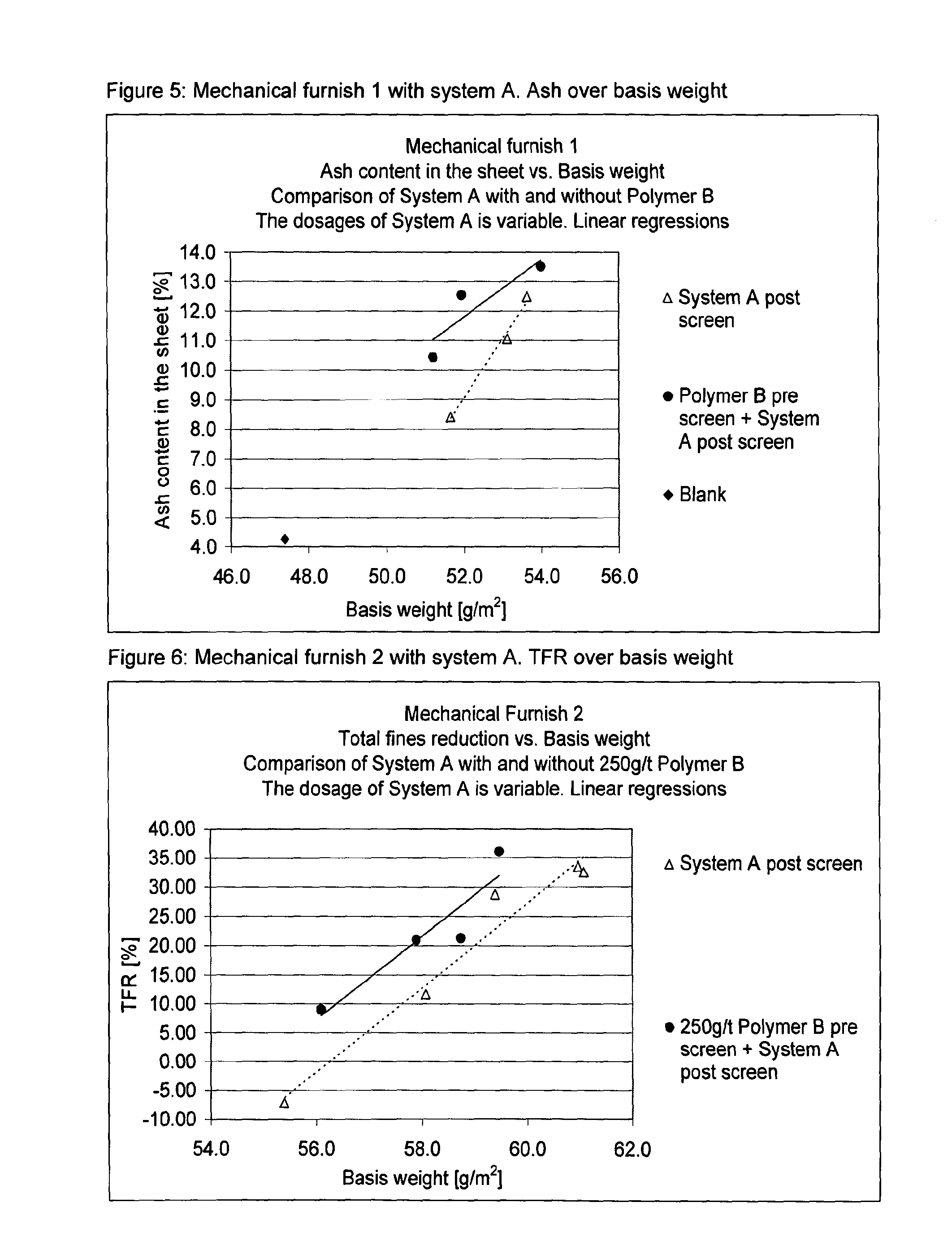Manufacture of paper or paperboard
a filling and paperboard technology, applied in the field of filling paper or paperboard manufacturing, can solve the problems of difficult to obtain the optimum balance, and inability to achieve the optimal balance, so as to reduce the relative level of fibre retention, reduce the level of fibre, and increase the level of filler
- Summary
- Abstract
- Description
- Claims
- Application Information
AI Technical Summary
Benefits of technology
Problems solved by technology
Method used
Image
Examples
examples
Methods
1. Preparation of Polymers
[0102]All polymers and coagulants are prepared as 0.1% aqueous solutions based on actives. The premixes consist of 50% high molecular weight polymer and 50% coagulant and are blended together as 0.1% aqueous solutions before their addition to the furnish.
[0103]Starch was prepared as 1% aqueous solution.
2. Polymers Used for the Examples
[0104]Polymer A: linear polyacrylamide, IV=9, 20% cationic charge. A copolymer of acrylamide with methyl chloride quaternary ammonium salt of dimethylaminoethyl acrylate (80 / 20 wt. / wt.) of intrinsic viscosity above 9.0 dL / g.
[0105]Polymer B: Anionic branched copolymer of acrylamide with sodium acrylamide (60 / 40 wt. / wt.) made with 3.5 to 5.0 ppm by weight methylene bis acrylamide branching agent as described in the invention. The product has a rheological oscillation value of tan delta at 0.005 Hz of 0.9.
[0106]The product is supplied as a mineral oil based dispersion with 50% actives.
[0107]Polymer C: Anionic, substantiall...
example i
Fine Paper Furnish with Systems A and B
[0130]This example demonstrates the invention in a chemical pulp furnish. The addition of a water soluble, anionic, first polymeric retention aid (polymer B) mechanically degrading the flocs, reflocculating the suspension by adding a solution of a water soluble, cationic, second retention aid (systems A or B) increases the ash content in the sheet at a given basis weight (see tables 1.1-3 as well as FIGS. 2 and 3). This has the benefit of allowing paper sheets to contain higher level of filler and a reduced level of fibres. It also allows the papermaker to produce a certain basis weight having a higher filler level without adjusting the thin stock towards higher ash loadings. It should be noted that higher ash loadings result in lower total retention in which event the thin stock consistency has to be increased to compensate for this effect. In turn, high thin stock consistencies combined with low retention often negatively impact sheet forming...
example ii
Mechanical Furnish 1 with System A
[0135]The mechanical furnish in this example is similarly prepared to the fine paper furnish in example I in terms of PAC and starch addition. It appears that the novel flocculating system (polymer B pre screen+system A post screen) significantly increases ash retention relative to total retention. Thus the process provides means for incorporating more filler into the paper sheet (see tables II.1, II.2 and FIG. 5). The preferred ash retention is confirmed by an increased reduction of fine particulate material between 0.8 and 10 microns (see tables II.1, II.2 and FIG. 2). The dosage of total actives to achieve a certain ash level relative to basis weight is also reduced with the present process.
[0136]
TABLE II.1No addition of polymer B, dosage of system A = variableFirst PassFirst PassDosage ofTotalTotal AshAsh contentBasisTotal finesSystem ARetentionRetentionin sheetweightreduction[g / t][%][%][%][g / m2][%]20073.229.98.451.610.740075.340.411.053.125.360...
PUM
| Property | Measurement | Unit |
|---|---|---|
| Percent by mass | aaaaa | aaaaa |
| Percent by mass | aaaaa | aaaaa |
| Percent by mass | aaaaa | aaaaa |
Abstract
Description
Claims
Application Information
 Login to View More
Login to View More - R&D
- Intellectual Property
- Life Sciences
- Materials
- Tech Scout
- Unparalleled Data Quality
- Higher Quality Content
- 60% Fewer Hallucinations
Browse by: Latest US Patents, China's latest patents, Technical Efficacy Thesaurus, Application Domain, Technology Topic, Popular Technical Reports.
© 2025 PatSnap. All rights reserved.Legal|Privacy policy|Modern Slavery Act Transparency Statement|Sitemap|About US| Contact US: help@patsnap.com



